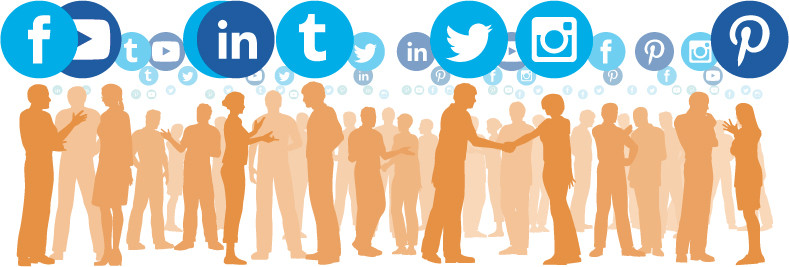Blog

PR Case study: Steps to get your content read, viewed and remembered
https://youtu.be/LsxlmhBPoE0 Shaping Influence®: Connecting brands with target audiencesInfluencer communications is a concept that eludes many of our fellow flacks and marketers, for whom the inability to prove a campaign's value and financial worth is increasingly problematic. Believe it or not, some companies are okay with that, and results that hover close to the status quo. They're complacent, led by managers who care just enough to make sure current strategies perform close to expectations.
While results bordering a notch or two above grossly underwhelming may merit a participation trophy, empowered brands have a shaping influence on the marketplace that can be measured.
Influencers: Engagement or Communications?Influencer Communications is a 360-degree approach to communications and marketing. Combining tried and true marketing methods with multichannel engagement ensures that the right messages reach the right person at the right time. While you might not be leveraging celebrity or micro-influencers of any type right now, there are some high-value candidates walking your hallways, working at the next cubicle, and sitting across from you in meetings.
It’s your own employees. Why Social Selling is so successful Employee Advocacy & Social Selling on LinkedInWhere traditional marketing relies on sponsored posts, re-marketing, paid placements and ads, Influencer Communications are organic and tap into the existing social reach of your workforce - from the C-Suite on down.
Smart companies are hiring sales and biz dev people that take full advantage of LinkedIn, Twitter, MeetUp Groups and Facebook to keep in touch with former, current and potential customers, agents and potential partners.
It boggles my mind - really - how such a powerful tool is so tragically underutilized. People from all departments can positively influence perception, and communications and marketing teams can measure the value of their engagement.
Posts from corporate accounts are necessary, and for the most part, serve a distinct purpose. But when friends and trusted colleagues recommend an article, case study or research report, it's personal. Authenticity counts, and every click, like, and share helps populate evergreen newsfeeds with your brand's messages.
Influencer Communications need as many people as possible in your company to get involved. Your executives, business development team and anyone else that drives day-to-day operations are directly (or indirectly) connected to your target audience.
Influencer Communications First StepsInfluencer Communications begins with content that your brand ambassadors can leverage.
Content type and message can vary depending on your industry and target customer. Some popular choices include multimedia, infographics, video testimonials and case studies, white papers, blogs, etc, In most cases, it’s considered best practice to develop assets that fall into all of these categories.
The more assets you have, the better your chances that employee advocacy and brand ambassador campaigns will move the proverbial needle. With some planning, building a cache of assets can be done quickly. For example, marketers can dissect a single case study into a variety of photos, videos, blogs and other repurposed assets.
Employee Advocacy with CEI: JMRConnect's award-winning platformAs you’re developing your assets, be mindful of the methods by which you plan to use them. The many social media platforms will become an integral part of your plan. Analyzing your target audience will tell you which you should be using — and avoiding. If your target audience isn’t using Instagram, it might not make sense to produce many photo-based assets.
As I mentioned in a previous article, LinkedIn is an essential medium of B2B marketing. Hubspot found that traffic from LinkedIn generated the highest visitor-to-lead conversion rate at 2.74 percent, almost three times (277 percent) higher than Twitter (.69 percent) and Facebook (77 percent). If your company has any focus on B2B transactions, it would behoove you to focus on developing blogs and thought leadership articles that can be shared on LinkedIn.
Facebook is also a very powerful messaging medium. In a study conducted by Facebook, Unicorn: A System for Searching the Social Graph, the company indicated that the average Facebook user has approximately 130 friends. Leveraging those friends of your employees, and their friends, can have an exponential effect in spreading your message.
Inform & Educate: Bridge the Gap Between Sales and Marketing Bridge the Gap Between Marketing & SalesOnce you identify the mediums best for your business and create assets, it’s time to get your employee involved. An influencer-based engagement effort should be clearly articulated to employees, easy for them to participate in, and potentially even incentivized.
All assets should be easy to locate and your employees should be given tools to help them share the content quickly and easily.
For example, to drive and sustain adoption, program managers must regularly provide a list of assets (perhaps via a weekly email), along with pre-written comments they can use in their social media posts. Again, the goal is to make sharing brand content as simple as possible for employees, removing any points of friction. This method also has the benefit of creating a unified message.
If you share content, you must measure the effectiveness of engagement to its being shared with the right people via the right medium. There are, of course, tools to help this measuring and analysis of the effectiveness of your engagement.
Do Influencer Communications Work?Ummm...you tell me?
Award-winning Employee AdvocacyRecent studies show how influencer-based marketing outperforms traditional methods by a wide margin. Collective Bias, a company specializing in influencing campaigns for brands and retailers, performed a recent study that underscored the value of influencer content. Results showed that consumers view content from influencers seven times longer than a digital display ad (two minutes and eight seconds compared to 19.2 seconds).
Shaping Influence with Viral Marketing Social sharing on LinkedIn is very powerful.All those statistics aside, we shouldn’t need any data other than common sense to know that Influencer Communications is effective. This descendant of word-of-mouth marketing is tailored for digital communications.
Research from Nielsen shows that 92 percent of consumers trust word of mouth recommendations over any other form of advertising. Research from Ogilvy, Google, and TNS that showed that 74 percent of consumers identify word-of-mouth as a key influencer in their purchasing decision.Influencer Communications takes the “word-of-mouth” and augments it with communication on social media. Despite the change in how the message is being delivered, the outcome is the same: highly effective engagement that moves the needle and bring in sales.
Lastly, barrier to entry is very low, because the delivery mechanism is already on your payroll...in case you needed another reason to buy-in.
Marketing professionals take note: YouTube's website is getting a big makeover. Business Insider reports that starting Tuesday, you'll be able to preview the video site's new design by signing up here. It'll eventually roll out to everyone. Neal Mohan, YouTube's product boss, announced the change at the Collision tech conference in New Orleans.
The update is based on Material Design, Google's home-grown design language in Android, Chrome, and (full story)
In a recent Shaping Influence article, Paula Bernier explains a bit about the importance of engagement. Why have the faces of anonymous models on the covers of magazines and in TV commercials been replaced with those of celebrities, musicians and supermodels? The answer is influence.
Style makers from the big (meaning movie) and small (now including computer and smartphone as well as TV) screens can, of course, be actresses and singers, as well as the kid down the block or a popular blogger. Indeed, the internet has democratized the world of communications and influence. But the fact remains that there are still some people who are able to draw a (physical and/or virtual) crowd and impact the decision making of those around them.
These individuals have come to be known as influencers. And these influencers are shaking up the worlds of advertising and marketing.
Influencer marketing is the fastest-growing online customer acquisition channel of those marketers polled by Tomoson, which estimates that businesses make $6.50 for every dollar they spend on influencer marketing. About 40 percent of those polled by analytics company Annalect and Twitter said they've purchased an item online after seeing it used by an influencer on Instagram, Twitter, Vine or YouTube. And Digital Visitor says influencer marketing has become an essential part of the strategies in the fashion, hospitality, retail and travel sectors.
Anthony Rawlins, managing director for Digital Visitor, in a recent report noted that a Google study from 2014 indicates the internet is the clear leader in inspiring leisure travel decisions, while TV follows as a distant second. Yet, he added, it can be difficult to track the impact of influencer marketing due to a lack of industry standards of measurement related to it. However, Rawlins said that organizations with an interest in engaging with influencers in an effort to promote their products might consider inviting these individuals to participate in themed experiences. For example, he suggested, a business could invite an influencer and his or her mother to be part of a Mother’s Day event or promotion. Twitter Chats are another means of connecting with influencers and their followers...continue reading
Mostafa Razzak, JMRConnect's Principal talks with Jennifer Schiff about business strategies for social media engagement.
“Keep your finger on the pulse of industry-specific conversations and engage with thoughtful questions and helpful answers,” says Mostafa Razzak, principal, JMRConnect, a public relations & influencer communications company. “Do not patronize or waste people’s time by stating the obvious or making comments that show you haven’t paid attention to what they’ve written or the message they’re trying to convey.” CLICK HERE to read the full article and insights from other industry experts.
Recently on Shaping Influence, Tracey Schelmetic notes how when social media was a few years old, and expanded beyond family vacation photos and cat videos, marketers started to become aware of something interesting: unlike any channel in the past, it could be used to spread subtle messages virally, particularly through the people who wielded a lot of influence in social media. Smart companies began creating messages that were mostly likely to be shared virally, particularly by people who had a lot of friends and followers. They began calling it “influence marketing."
Since the earliest days of social media, customers have begun to use these platforms for more than memes and selfies. They’ve begun following the companies they like, sharing worthwhile information, and even using the channels to communicate with companies for customer support or feedback.
“The degree of influence varies from person to person and platform to platform,” wrote Maggie Marton for BlogPaws recently. “But the core concept is the same: You are known to your readers. They like you. Most importantly, they trust you. So, when you suggest a product or ask for a click or a share, they’re more included to do it than if it came from, say, a big retailer.”
In the same way that people trust the opinions of friends and family more when it comes to recommendations on purchasing decisions...KEEP READING
Shaping Influence: It's not enough to just have great content any more; much like it was with data, great content needs to be used effectively to get the most out of it. Technavio recently examined the market for content authoring tools worldwide, and revealed four big points that were set to shape this market for the next several years, up into 2020. There were some big changes to come, and with these changes, opportunity. A market that's set to clear $126 billion in 2020, e-learning content can come from a lot of places, and schools and universities are actively looking for e-learning content in a bid to augment current offerings. E-learning covers a host of formats...Click Here to read more >>>
Influencer Communications, also known as “Influencer Engagement,” is a powerful marketing approach that combines next-generation and traditional marketing methods and funnels them to and through purchasing influencers of various types. While you might not be leveraging influencers of any type right now, there is one that is walking your hallways, working at your desks, and sitting across from you in meetings. It’s your own employees. Due to their relationships and social media connections to current and potential customers, your executives, business development team, and anyone else in the company that helps drive day-to-day operations are directly or indirectly connected to your target audience. As such, the goal for Influencer Communications is to get everyone in your company involved in outreaching to your target audience.
A prerequisite of Influencer Communications is having content your influencers can leverage. Content can vary depending on your industry and target customer; however it is common to develop assets such as case studies, white papers, blogs, videos, and photos. In most cases, it’s considered best practice to develop assets that fall into all of these categories. As we will discuss, having many assets will improve your influencers’ abilities to succeed. Click here to continue reading
Congressional staffers influence, research, craft and write legislation that could have a huge impact on your association, nonprofit or corporation. So, it goes without saying, building a relationship with the right Hill workers for your industry is key. But how do you do it in a way that not only gets you in front of the people you want, but leaves behind the right impression to get your issue moving? Here’s what they said in Congressional Quarterly's Connectivity>>>
"The 2016 Mobile Payments Conference in Chicago is where industry leaders gather to separate fact from fiction," said Marla Ellerman, Mobile Payments Conference executive director and publisher of Mobile Marketing & Technology. "This year's conference will examine the many new mobile commerce platforms, services, solutions, and standards that continue to enter this exploding market."...It is being widely believed that blockchain technology, in particular, could revolutionize payment systems. Banks and tech companies are seeking to tap its potential. BNY Mellon recently said that blockchain could “significantly shake-up payments” by making transactions near-instantaneous. Click here to read the full story >>>
Shaping Influence: There's no doubt that social media is drawing users. It's also proving to be one of the more popular methods to get in touch with a brand by regular consumers. That contact works both ways, and major brands are increasingly turning to social influencers to draw attention and potential customers to a brand. Read Steve Anderson's take on Shaping Influence how SharkReach is tackling influencer engagement>>>
In this insight-filled interview with Joe Arena, the Senior Vice President of Advanced Services at video managed service provider Yorktel, we dig into what a video communications assessment project looks like, the components businesses should take into consideration when performing an assessment and how to take remote workers and external stakeholders into consideration when planning your approach. Listen here >>>
Capital One, Google, Discover, FIS Global, Worldpay, Hewlett Packard, NEC, Accenture Digital, GfK Financial, McKinsey & Company, Aite Group, and Zooz Executives Among Presenters at 2016 Mobile Payments Conference in Chicago.
“Influencer Communications,” or “Influencer Engagement” is more than a buzzword; it’s a formula that combines multi-channel advocacy, content and social marketing with "traditional" public relations and corporate communications. From analysts and media to customers, employees and partners, the types of influencers — and ways they’re in which they’re engaged — vary, and are what make this method unique. Check out my latest post on Shaping Influence for insight on identifying influencers, engaging and quantifying success. Click here >>>
The latest installment in Shaping Influence sheds light on some very interesting data. Findings from Collective Bias's Time on Content feature, which offers a key indicator as to the relevancy of influencer content, consumers view their influencer content for an average duration of two minutes and eight seconds—almost seven times longer than the digital display ad average of 19.2 seconds based on viewability standards measured by Moat Analytics. Click here to read more on this compelling report >>>
The latest on Shaping Influence. In this post, contributor Chris Hale, CEO and Founder of kountable, Inc., talks about developing Social Capital. Click here to read Chris's insight on how you can attract, engage and convert influencers >>>
The IMA announced the launch of its Mid-Atlantic Chapter, and the appointment of JMRConnect Principal, Mostafa Razzak as the Region’s Chairman and Executive Director. With more than 1,000,000 professional members worldwide, the Internet Marketing Association is the industry’s fastest growing organization. The IMA Mid-Atlantic Group will serve as an open platform for business and economic development; education and skills training; and as an interactive forum through which to network, share best practices and collaborate. Click here to continue >>>
Contributor Peter Scott examines how to identify the right influencers for your content and digital engagement. Read his post in Shaping Influence>>>
Very interesting article from Corporate Tech Decisions magazine on the varying factors that must be addressed to create a viable Next Gen Workplace. Multiple, real-time technologies must work together seamlessly for this experience to become a reality. Click here to read the full text >>>
Gamification can have far more serious results for businesses than just fun and games. By leveraging the competitive dynamics of games that make playing so addictive, companies can actively engage customers and employees to encourage loyalty, ignite brand advocates, and reward behaviors that sustain - and grow - the business. Click here to read how by addressing three critical factors, gamification can deliver results far beyond raising brand awareness.
Archives
- October 2024
- September 2024
- August 2024
- July 2024
- June 2024
- May 2024
- October 2019
- October 2018
- June 2018
- December 2017
- September 2017
- August 2017
- July 2017
- June 2017
- May 2017
- April 2017
- March 2017
- February 2017
- January 2017
- December 2016
- November 2016
- September 2016
- August 2016
- July 2016
- June 2016
- May 2016
- April 2016
- March 2016
- February 2016
- January 2016
- December 2015
- May 2014
- April 2014
- March 2014
- April 2013
- March 2013
- January 2013
- August 2012
- July 2012
- May 2012
- March 2012
- February 2012
- November 2011
- October 2011
- September 2011
- August 2011
- June 2011
- April 2011
- March 2011


















